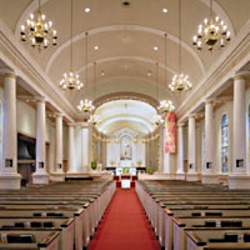Editor’s Note: While this article discusses delays in a theater environment, the information can be applied to any situation.
In an ideal world, the best system would be a single point source that would cover every single seat in the house at the same level with the same frequency response.
This is easy to state, tough to execute. Most theaters have walls, ceilings, domes, balcony boxes and balcony fronts, chandeliers, canopies, sidewall projections, pillars, pilasters, plaster pachyderms, which get in the way of that ideal single point source.
Getting sound into a room is easy. There are a lot of boxes on the market that will throw sound as far as you want to heave it.
The problem is what comes back because for every action there is an equal and opposite reaction. If sound hits a plaster back wall, it’s bouncing off the wall at about the same level. If there is any focusing going on, the reflections are greater, and it’s goodbye to that ideal world.
Delay systems offer a good solution to combat reflection problems. Minimizing a reflection requires either changing the angle of the sound incidence, reducing the level of the sound hitting the wall, or both. Adding delay speakers extends the reach of a system and makes reducing unwanted reflections possible.
In large touring productions, delay systems are usually standard with the shows carrying everything necessary to hang several zones. A system design, such as Martin Levan’s Showboat, could devote as much of the processing and amps to the delays as the mains.
Although the delay system for a show that goes above 100 dB-SPL, such as Rent, will be different from a book show, the intent is the same. The idea is to get speakers as close to the audience as possible thereby keeping the levels in all speakers as low as possible to ward off the bounces.
Where the main system can be hung may be fine for the main floor, but it could be the wrong position to cover under the balcony. Delays hung in the correct position at a better angle than the mains will get sound directly onto the audience that would be blocked from the mains.
As the delays are closer, they are subject to less air loss so the highs are crisper. The mains do not need to be as loud because they do not have to throw that extra distance.
There isn’t any direct sound hitting the dome under the balcony. The engineer will not be as likely to over EQ because usually the mix position is at the back of the main floor and they can now hear full bandwidth.















